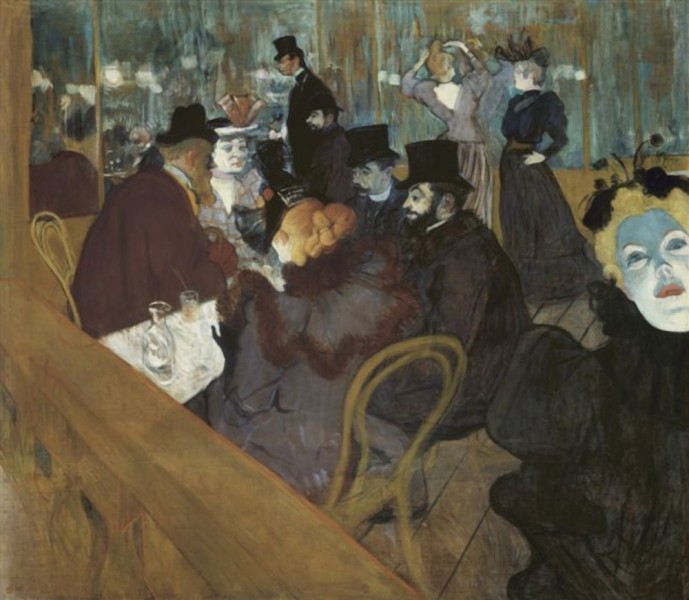 Henri de Toulouse-Lautrec, At the Moulin Rouge, 1892/95, oil on canvas, 48 7/16” x 55 ½”, Art institute of Chicago, Public Domain via Wikimedia Commons.
Henri de Toulouse-Lautrec, At the Moulin Rouge, 1892/95, oil on canvas, 48 7/16” x 55 ½”, Art institute of Chicago, Public Domain via Wikimedia Commons.
Henri Marie Raymond de Toulouse-Lautrec-Monfa, also known as Henri de Toulouse-Lautrec, was an aristocrat living the life of a bohemian artist in the lively Montmartre section of Paris in the late 19th century. When the Moulin Rouge, a cabaret, opened he became a fixture at the institution, eventually earning a supplement to his family income by creating remarkable lithographic posters for the nightclub.
Toulouse-Lautrec’s At the Moulin Rouge, includes a self-portrait in the center of the painting seated among his friends. At the right, the woman with the face the color of absinthe is the English singer May Milton who possibly was the lover of the redhead standing in the back of the room, Toulouse-Lautrec’s muse, the dancer Jane Avril.
Toulouse-Lautrec’s Post-Impressionist style betrays many influences. Like his friend Vincent van Gogh, he used color freely and expressively, often pulling complementary hues together to make his exaggerated forms pop. Similar to Gauguin, he offers a high point of view and flattens out the composition with broad, flat shapes like those he admired in Japanese prints.
 Henri de Toulouse-Lautrec, At the Moulin Rouge, 1892/95, oil on canvas, 48 7/16” x 55 ½”, Art institute of Chicago, Public Domain via Wikimedia Commons.
Henri de Toulouse-Lautrec, At the Moulin Rouge, 1892/95, oil on canvas, 48 7/16” x 55 ½”, Art institute of Chicago, Public Domain via Wikimedia Commons.
 Henri de Toulouse-Lautrec, At the Moulin Rouge, 1892/95, oil on canvas, 48 7/16” x 55 ½”, Art institute of Chicago, Public Domain via Wikimedia Commons.
Henri de Toulouse-Lautrec, At the Moulin Rouge, 1892/95, oil on canvas, 48 7/16” x 55 ½”, Art institute of Chicago, Public Domain via Wikimedia Commons.

